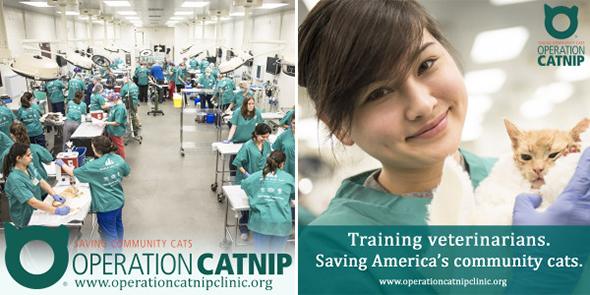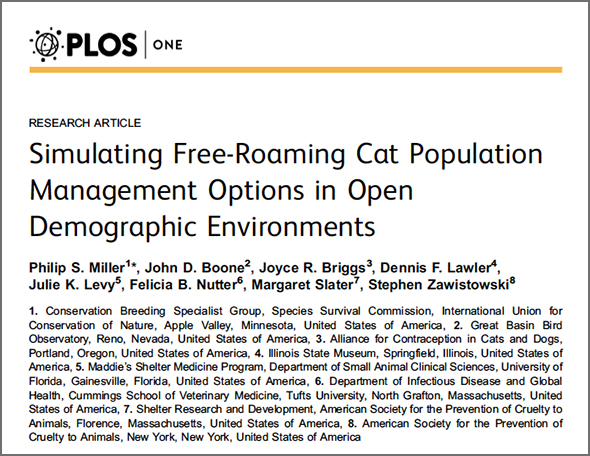An open letter to the American Veterinary Medical Association, in response to the publication of “Cats may be greater threat to wildlife than first thought,” in the April issue of the Journal of the American Veterinary Medical Association:
As an advocate of trap-neuter-return working for one of that nation’s leading animal welfare organizations, Best Friends Animal Society—and somebody quite familiar with the science surrounding TNR and free-roaming cats in general—I feel compelled to respond to R. Scott Nolen’s recent article (“Cats may be greater threat to wildlife than first thought,” JAVMA News, April 1, 2013) about the paper published earlier this year by the Smithsonian Conservation Biology Institute and U.S. Fish and Wildlife Service (USFWS). Careful scrutiny reveals a number of flaws in the work, and challenges Nolen’s suggestion that that the researchers involved “took a rigorous and conservative approach” when developing their headline-grabbing predation estimates. Although a detailed critique is beyond the scope of this letter, a brief overview of the more glaring weaknesses will, I think, make the point.
The 1.4–3.7 billion annual bird mortalities reported by Scott Loss, Tom Will, and Peter Marra (which they describe throughout their paper as a conservative estimate [1]) represent an astonishing 29–76 percent of the estimated 4.7 billion land birds in all of North America, [2] a “contribution” that would very likely have led to the extinction of numerous bird species long ago. Even if, as some have suggested, “the total [population of land birds] could be 2 to 3 times higher in some regions,” [3] the implied impact due to predation by cats is simply not supported by existing data. Indeed, 57 of the 58 native bird species Loss et al. claim are targeted by cats have been given a “Least Concern” conservation status by the International Union for Conservation of Nature (IUCN). [4] The one exception, the Northern Bobwhite, is considered “Near Threatened” due largely to “widespread habitat fragmentation” and extensive hunting. [5] Moreover, the populations of at least 23 of those 58 species are, as indicated by nearly 45 years of North America Breeding Bird Survey data, [6] stable or increasing.
Among the factors contributing to the authors’ inflated estimates is their assumption that 40–70 percent of owned cats are not only allowed to go outdoors, but are, as far as their model is concerned, outside 24/7. [1] In fact, surveys suggest that approximately 60 percent of these cats are indoor-only, and that those allowed outdoors are outside for no more than three hours each day. [7, 8].
This error is, in turn, compounded by the “correction factor to account for owned cats not returning all prey to owners” [1] used by Loss et al. The low-end of the range they used in their model (2.0–3.3) can be traced to a misreading of a 1974 paper published in The Wilson Bulletin, [9] while the upper-end was derived from observations of 12 cats successfully capturing “small mammals” rather than birds (which were observed to avoid capture). [10] The two errors alone inflate the predation rate attributed to pet cats by a factor of 10–20.
The claim made by Loss et al that about 69 percent of cat-killed birds and 89 percent of cat-killed mammals in the U.S. are killed by unowned cats is similarly flawed. Five of the eight studies the authors included in their analysis were conducted in the 1930s and 1950s, when it wasn’t unusual for researchers studying the diet of cats to simply shoot whatever cats could be found hunting along roadsides (or picked up dead, having been killed by a passing vehicle). [11] Setting aside the obvious ethical objections, such methods are, at best, useful for determining what the cats were hunting, but tell us very little about the frequency of their hunting efforts—and nothing whatsoever about any impact on prey populations.
And the estimate by Loss et al. that 80–100 percent of unowned cats kill wildlife relies exclusively on studies of rural cats. Research conducted in more densely populated areas, or areas where unowned cats aren’t entirely reliant on prey for their meals, reveals predation rates far lower than 80 percent, [12] especially for birds. [13] Again, one flaw is compounded by another, resulting in grossly inflated predation estimates.
Especially puzzling is the authors’ assertion that “projects to manage free-ranging cats, such as Trap-Neuter-Return colonies, are potentially harmful to wildlife populations.” [1] Not only do Loss et al. provide no evidence to support such a claim, they overlook an often-cited study that has documented predation by colony cats. Over the course of approximately 300 hours of observation (this, in addition to what the researchers describe as “several months identifying, describing, and photographing each of the cats living in the colonies” prior to beginning their research) in two Miami-Dade County (FL) parks, Castillo and Clarke “saw cats kill a juvenile common yellowthroat and a blue jay. Cats also caught and ate green anoles, bark anoles, and brown anoles… [and the researchers] found the carcasses of a gray catbird and a juvenile opossum in the feeding area.” [14] There were, at any one time, 85–95 cats across the two study sites—more than enough opportunity for documenting the kind of extensive predation suggested by Loss et al.
While it’s true, as Nolen suggests, that the IUCN “lists the domestic cat among the world’s 100 worst invasive alien species,” it’s important to point out that this designation has mostly to do with their impact on wildlife native to oceanic islands. [15] And as researchers Dennis Turner and Mike Fitzgerald explained 13 years ago, “there are few, if any studies apart from island ones, that actually demonstrate that cats have reduced bird populations.” [16] As Louise Holton, president and founder of Alley Cat Rescue, points out in the article, cats—like all predators—tend to prey on the young, the old, the weak and unhealthy. At least two studies have investigated this in great detail, revealing that birds killed by cats are, on average, significantly less healthy than birds killed through non-predatory events (e.g., collisions with windows or cars). [17, 18] “Despite the large numbers of birds killed, there is no scientific evidence that predation by cats in gardens is having any impact on bird populations UK-wide,” notes the Royal Society for the Protection of Birds on its website. “It is likely that most of the birds killed by cats would have died anyway from other causes before the next breeding season, so cats are unlikely to have a major impact on populations.” [19]
Last year, Loss et al. published a paper in which they pointed out that “national mortality estimates are often based on extrapolation from a limited sample of small-scale studies, and estimates of uncertainty are ignored or only superficially assessed.” [20] Ironically, the authors include some of these very studies in their more recent analysis. And by pooling studies from various contexts, attempting to “correct” for different methods, and so forth, they actually add to the uncertainty they lamented previously.
Also ironic is the fact that two of the three authors have advocated publicly for restrictions or outright bans on TNR, [21, 22] despite compelling evidence demonstrating its effectiveness. [23–30] Such policies would, it’s virtually guaranteed, actually increase the risk to the wildlife we all want to protect.
The real story here has little to do with conservation; it’s about how such shoddy science is funded by U.S. taxpayers, published, sold to the public, and used as rationale for policy decisions [31, 32] that would likely result in the deaths of millions of domestic cats. It’s disappointing and troubling to see the AVMA—whose mission is “to advance the science and art of veterinary medicine”—effectively endorse the Smithsonian/USFWS paper, giving it undeserved credibility.
Peter J. Wolf
Cat Initiatives Analyst
Community Programs and Services
National Programs
Best Friends Animal Society
Literature Cited
1. Loss, S.R., Will, T., and Marra, P.P., “The impact of free-ranging domestic cats on wildlife of the United States.” Nature Communications. 2013. 4. http://www.nature.com/ncomms/journal/v4/n1/full/ncomms2380.html
2. Rich, T.D., et al., Partners in Flight North American Landbird Conservation Plan. 2004, Cornell Lab of Ornithology: Ithaca, NY. www.partnersinflight.org/cont_plan/
3. Blancher, P.J., K. V. Rosenberg, A. O. Panjabi, B. Altman, J. Bart, C. J. Beardmore, G. S. Butcher, D. Demarest, R. Dettmers, E. H. Dunn, W. Easton, W. C. Hunter, E. E. Iñigo-Elias, D. N. Pashley, C. J. Ralph, T. D. Rich, C. M. Rustay, J. M. Ruth, T. C. Will, Guide to the Partners in Flight Population Estimates Database. Version: North American Landbird Conservation Plan 2004, in Partners in Flight Technical Series No 5. 2007. http://www.partnersinflight.org/
4. IUCN. The IUCN Red List of Threatened Species. 2012 [cited 2013 May 5]. 2012.2:[http://www.iucnredlist.org/.
5. n.a. (2012) Northern Bobwhite Colinus virginianus. IUCN 2012. IUCN Red List of Threatened Species http://www.birdlife.org/datazone/speciesfactsheet.php?id=30131 Accessed May 5, 2013.
6. Sauer, J.R., et al. (2012) The North American Breeding Bird Survey, Results and Analysis 1966–2011. Version 12.13.2011
7. Clancy, E.A., Moore, A.S., and Bertone, E.R., “Evaluation of cat and owner characteristics and their relationships to outdoor access of owned cats.” Journal of the American Veterinary Medical Association. 2003. 222(11): p. 1541–1545. http://avmajournals.avma.org/doi/abs/10.2460/javma.2003.222.1541
8. Lord, L.K., “Attitudes toward and perceptions of free-roaming cats among individuals living in Ohio.” Journal of the American Veterinary Medical Association. 2008. 232(8): p. 1159–1167. http://www.avma.org/avmacollections/feral_cats/javma_232_8_1159.pdf
9. George, W., “Domestic cats as predators and factors in winter shortages of raptor prey.” The Wilson Bulletin. 1974. 86(4): p. 384–396. http://elibrary.unm.edu/sora/Wilson/v086n04/p0384-p0396.pdf
10. Kays, R.W. and DeWan, A.A., “Ecological impact of inside/outside house cats around a suburban nature preserve.” Animal Conservation. 2004. 7(3): p. 273–283. http://dx.doi.org/10.1017/S1367943004001489
www.nysm.nysed.gov/staffpubs/docs/15128.pdf
11. Errington, P.L., “Notes on Food Habits of Southwestern Wisconsin House Cats.” Journal of Mammalogy. 1936. 17(1): p. 64–65. http://www.jstor.org/stable/1374554
12. Calhoon, R.E. and Haspel, C., “Urban Cat Populations Compared by Season, Subhabitat and Supplemental Feeding.” Journal of Animal Ecology. 1989. 58(1): p. 321–328. http://www.jstor.org/pss/5003
13. Hawkins, C.C., Impact of a subsidized exotic predator on native biota: Effect of house cats (Felis catus) on California birds and rodents. 1998, Texas A&M University.
14. Castillo, D. and Clarke, A.L., “Trap/Neuter/Release Methods Ineffective in Controlling Domestic Cat “Colonies” on Public Lands.” Natural Areas Journal. 2003. 23: p. 247–253.
15. n.a. (2010) Felis catus (mammal). The Global Invasive Species Database http://www.issg.org/database/species/ecology.asp?si=24&fr=1&sts=&lang=EN
16. Fitzgerald, B.M. and Turner, D.C., Hunting Behaviour of domestic cats and their impact on prey populations, in The Domestic Cat: The biology of its behaviour, D.C. Turner and P.P.G. Bateson, Editors. 2000, Cambridge University Press: Cambridge, U.K.; New York. p. 151–175.
17. Møller, A.P. and Erritzøe, J., “Predation against birds with low immunocompetence.” Oecologia. 2000. 122(4): p. 500–504. http://www.springerlink.com/content/ghnny9mcv016ljd8/
18. Baker, P.J., et al., “Cats about town: Is predation by free-ranging pet cats Felis catus likely to affect urban bird populations?“ Ibis. 2008. 150: p. 86–99. http://www.ingentaconnect.com/content/bsc/ibi/2008/00000150/A00101s1/art00008
19. RSPB (2011) Are cats causing bird declines? http://www.rspb.org.uk/advice/gardening/unwantedvisitors/cats/birddeclines.aspx Accessed October 26, 2011.
20. Loss, S.R., Will, T., and Marra, P.P., “Direct human-caused mortality of birds: improving quantification of magnitude and assessment of population impact.” Frontiers in Ecology and the Environment. 2012. 10(7): p. 357–364. http://www.esajournals.org/doi/abs/10.1890/110251
21. Marra, P. (2011, March 18). No good for the birds, but also no good for the cats (Opinion). The Washington Post, from http://www.washingtonpost.com/opinions/no-good-for-the-birds-but-also-no-good-for-the-cats/2011/03/17/ABLGkvr_story.html
22. Will, T., What Can Federal Agencies Do? Policy Options to Address Cat Impacts to Birds and Their Habitats, in Bird Conservation Alliance Teleconference. 2010. http://www.animalliberationfront.com/Practical/Pets/PetCare/Cats/ABC%20Cats-TNR-Policy%20Will%2028Jan10.pdf
23. Levy, J.K., Gale, D.W., and Gale, L.A., “Evaluation of the effect of a long-term trap-neuter-return and adoption program on a free-roaming cat population.” Journal of the American Veterinary Medical Association. 2003. 222(1): p. 42–46. http://avmajournals.avma.org/doi/abs/10.2460/javma.2003.222.42
24. Nutter, F.B., Evaluation of a Trap-Neuter-Return Management Program for Feral Cat Colonies: Population Dynamics, Home Ranges, and Potentially Zoonotic Diseases, in Comparative Biomedical Department. 2005, North Carolina State University: Raleigh, NC. p. 224. http://www.carnivoreconservation.org/files/thesis/nutter_2005_phd.pdf
25. Natoli, E., et al., “Management of feral domestic cats in the urban environment of Rome (Italy).” Preventive Veterinary Medicine. 2006. 77(3-4): p. 180–185. http://www.sciencedirect.com/science/article/B6TBK-4M33VSW-1/2/0abfc80f245ab50e602f93060f88e6f9
www.kiccc.org.au/pics/FeralCatsRome2006.pdf
26. Tennent, J., Downs, C.T., and Bodasing, M., “Management Recommendations for Feral Cat (Felis catus) Populations Within an Urban Conservancy in KwaZulu-Natal, South Africa.” South African Journal of Wildlife Research. 2009. 39(2): p. 137–142. http://dx.doi.org/10.3957/056.039.0211
27. Mendes-de-Almeida, F., et al., “The Impact of Hysterectomy in an Urban Colony of Domestic Cats (Felis catus Linnaeus, 1758).” International Journal of Applied Research in Veterinary Medicine. 2006. 4(2): p. 134–141. www.jarvm.com/articles/Vol4Iss2/Mendes.pdf
28. Mendes-de-Almeida, F., et al., “Reduction of feral cat (Felis catus Linnaeus 1758) colony size following hysterectomy of adult female cats.” Journal of Feline Medicine & Surgery. 2011.
29. Robertson, S.A., “A review of feral cat control.” Journal of Feline Medicine & Surgery. 2008. 10(4): p. 366–375.
30. Donlan, A.E. (1996, June 30). North Shore cat-lovers go… Where the wild things are. Boston Herald,
31. Fenwick, G.H. (2013, February 25). House cats: The destructive invasive species purring on your lap. The Baltimore Sun, from http://www.baltimoresun.com/news/opinion/oped/bs-ed-cats-20130225,0,6415585.story
32. Lynes, M. (2013, February 4). No. 1 bird killer is outdoor cats. San Francisco Chronicle, from http://www.sfgate.com/default/article/No-1-bird-killer-is-outdoor-cats-4250692.php

 There is a kind of certainty that comes from having thoroughly investigated a problem, prodding and poking at it from every angle, taking into careful consideration all possible explanations. And there’s the kind that comes from not knowing what the hell you’re talking about.
There is a kind of certainty that comes from having thoroughly investigated a problem, prodding and poking at it from every angle, taking into careful consideration all possible explanations. And there’s the kind that comes from not knowing what the hell you’re talking about.
